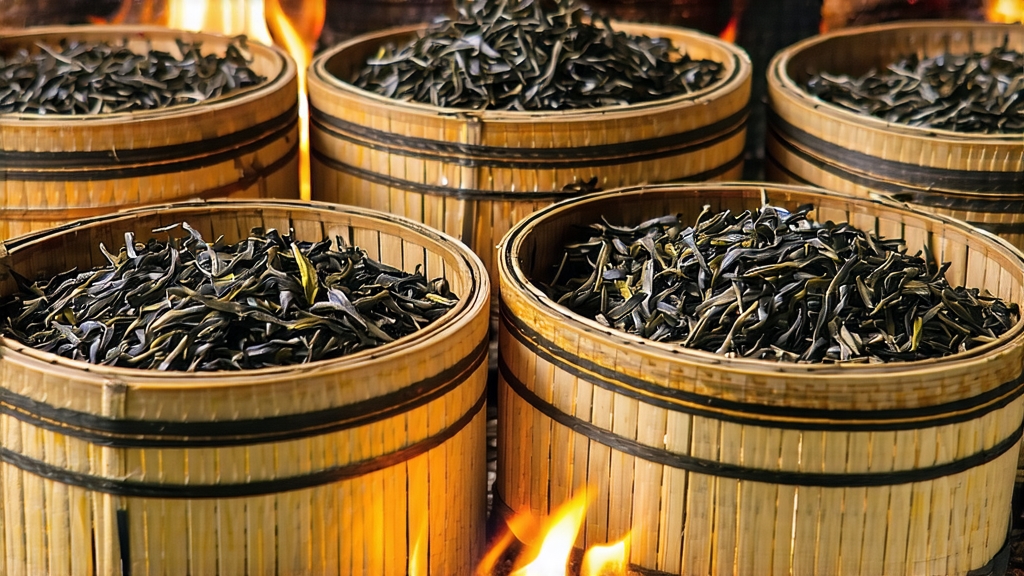
Ask most tea lovers to name China’s oldest black tea and the answer is usually “Keemun” or “Yunnan Gold.” Few realize that both trace their pedigree to a tiny village tucked inside the granite gorges of the Wuyi Mountains in Fujian province. There, in the hamlet of Tongmu, the world’s first fully oxidized leaf was born in the mid-seventeenth century under the poetic name Zheng Shan Xiao Zhong—today marketed abroad as Lapsang Souchong. More than a curiosity, this pine-smoked black tea is the prototype that launched the global craving for red tea (the Chinese term for what the West calls black). From London’s dockside auctions to the court of Catherine of Braganza, Lapsang Souchong rode clipper ships across oceans, shaped breakfast rituals on two continents, and still refuses to be replicated anywhere else. Understanding its journey is therefore a crash course in Chinese tea ingenuity, terroir worship, and the alchemy of smoke.
Historical backdrop
The story begins around 1640, when Ming-dynasty soldiers transited through Wuyi, commandeering a tea factory overnight. To dry the piled leaves quickly for transport, workers spread them over pine fires. The resulting liquor—brisk, copper-red, laced with campfire aroma—delighted the Dutch traders who first carried it to Europe. By 1669 the British East India Company listed “Bohea Souchong” (a corruption of Wuyi and the grade xiao zhong, “small sort”) as its priciest lot, outbidding even the finest green teas. Centuries later, when the Queen of England requested a tea that could stand up to milk and sugar, blenders reached instinctively for Lapsang’s assertive leaf, cementing its role in English Breakfast blends. Meanwhile, the original Tongmu farmers guarded their smoke-curing secrets so jealously that outsiders were forbidden to enter the gorge until the 1980s, preserving both biodiversity and technique in a kind of living museum.
Terroir: why Tongmu cannot be photocopied
The Wuyi range is a UNESCO World Heritage site where subtropical mist wraps 1,800-metre peaks of volcanic rock. Day-night temperature swings of 15 °C slow leaf growth, concentrating amino acids and sugars. Soil is a sandy laterite laced with quartz and feldspar—mineral-rich yet fast-draining—forcing tea roots to struggle and deepen. Most important, the gorge’s micro-climate nurtures Masson pines and Chinese red pines whose resinous heartwood burns cool and long, the indispensable fuel for authentic smoking. Move the same Qing Xin cultivar ten kilometres downhill and the leaf loses its osmanthus sweetness; move the pine firewood to another county and the smoke turns acrid. Thus every legitimate Lapsang Souchong carries a terroir fingerprint as distinctive as Lafite in Bordeaux.
Two stylistic branches
- Traditional pine-smoked (Yan Xun Zheng Shan Xiao Zhong)
The classic, still made only in Tongmu. Fresh leaves wither over gentle pine embers, are rolled by hand on bamboo trays, oxidized inside wooden boxes, then re-dried in bamboo sieves suspended above a pinewood hearth. Up to nine hours of smoke layering imparts a glossy obsidian look and a scent that oscillates between longan fruit and cured bacon. Because the smoke acts as a natural preservative, well-stored versions mellow into honeyed complexity for decades. - Unsmoked “new craft” (Wu Yan Xiao Zhong)
In 2005 a Tongmu master removed the final smoking stage to satisfy domestic palates seeking malty sweetness without campfire notes. The result—golden tips, cocoa aroma, raisin finish—now outsells the smoked original inside China, but purists consider it a different tea altogether. Both styles share the same cultivar and withering rooms, so they offer an ideal A/B test for smoke influence.
Craft step-by-step
Picking: only the central three leaves, taken when the third leaf is still half-open, ensuring an even water content of 72–74 %.
Withering: carried out on bamboo racks above ground-level pine embers kept at 28–30 °C. The leaf loses 60 % moisture in four hours while absorbing volatile guaiacol and syringol—the molecules later read as “pine smoke